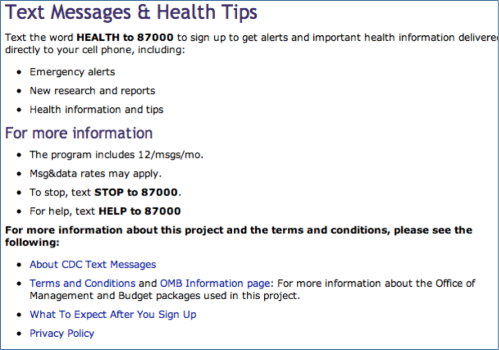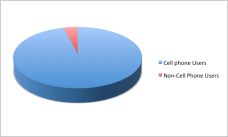
Objective: ?To provide an understanding of the various text message alert and warning tools available to public safety organizations and the pros and cons of their use.
The ability for public safety organizations to send people alerts, warnings, or even preparedness information to mobile devices has increasingly become a necessity, especially for communities that have large populations of citizens without ?home-phones? such as those surrounding college campuses. ?There are many pros and cons, however, and this post will explore some of the issues.
How does it work? ?SMS stands for?short message service. SMS is also often referred to as texting, sending text messages or text messaging. The? short? ?part of SMS refers to the length?the maximum size of the message is limited to 160 characters, including spaces.?(Twitter started as an SMS service, which is why the number of ?characters is limited.) If an organization would like to start sending text messages, this is usually done via contracts with outside vendors. ?There are several steps:
- An organization must first lease a short code?typically a 5-7 digit number;
- Once it is obtained then a set of keywords is identified so that users can text into the short-code to sign up;
- Once people have subscribed, an organization can send messages to the mobile service provider, which then sends the messages to a mobile aggregator;
- An SMS aggregator maintains direct connections to the major wireless carriers. They deliver their customers? text messages, which they aggregate, through their gateways.
- An aggregator allows you to go to one place to connect to all of the wireless carriers. The mobile carriers then distribute the message to your subscribers. (Source: CDC SM Toolkit)

To reach a large audience: Below, this excerpt from a?CDC publication which?outlines?who uses mobile technologies and texting, specifically. In general, the overall use of mobile technologies is on the rise:
 ?In 2010, 96% of U.S. adult population owns a mobile device (CTIA, 2010).
?In 2010, 96% of U.S. adult population owns a mobile device (CTIA, 2010).- Text message volume continues to increase; in 2010, more than 2.1 trillion short text messages (SMS) were sent ? up from 81 billion in 2005. CTIA, 2010).
- 72% of cell phone owners use their phone to send or receive text messages (Smith, A., 2010).
- Lower income teens (ages 12 ? 17) are higher users of text messaging and the mobile internet than their more affluent counterparts. Of the teens without home internet access, 20% use their mobile devices to access the internet (Smith, A., 2010).
- One third of Americans (35%) own smartphones.?Groups that have higher than average adoption rates include those well educated and affluent, individuals under the age of 45 and African-Americans and Latinos.
- The swift adoption of smartphones has lead to the increase of ?cell mostly? internet users. Some 87% of smartphone owners access the internet or email on their device. (Smith, A., 2011) (Source:?CDC SM Toolkit)
To Educate: The?CDC describes how they use this type of communication tool to not only inform, but to potentially influence and/or change behavior.?As an example, recent research has shown that sending people a daily text message to remind them to take medication dramatically increases the number of patients who stick to their prescription drug regimen. ?Text messages and emerging technologies offer new opportunities to educate and engage patients so they can improve their health and ultimately rein in their health costs,? Kalee Foreman of OptumRx, the study?s lead author, said in a statement. (Source:?http://www.startribune.com/business/154293125.html?refer=y)
To Alert:?SMS/text messaging systems have become are a major part of campus mass warning systems, which has also allowed for a good assessment of the tools.?According to Campus Safety Magazine?there are many ?strengths? to using these tools. For one, most college students (and research shows people in general) pay attention?to text messages they receive on their?cell phones.?Moreover, during a crisis when bandwidth is at a premium, SMS is a good choice because it?uses much?less than voice messages.
Disadvantages
With every ?pro,? there is usually a ?con? with the biggest issue being the necessity for people to proactively subscribe. This mirrors the problems that have been encountered by communities who use?Reverse 911-type systems that automatically calls every land line in the database. Users of that tool have seen a?drop-off?in the amount of people they are able to reach as more and more citizens rely on cellular service alone. The?Denver Post?recently investigated the issue:
?Reverse-dialing warning systems aren?t capable of sending alerts ? calls, texts or e-mails ? to cellphones unless a person?registers the number with the county?s emergency management office. This has been slow to catch on across Colorado, even as more people cancel their land lines in favor of using mobile phones only.
One advantage to SMS, however, is that subscribing to a text message service is much simpler than the online-lengthy form required for registration to ?reverse dialing systems.
Some other concerns about the technology include:
- Messages may be considered spam, even if they are emergency alerts, by?some communication companies and/or recipients (some cell service providers might even completely block message delivery?see this article: Is there a Gap in Your Mass Notification System Plan?)
- Cost?quite a few of these services are not free;
- If cellular service is disrupted, messages?might not go out or delivery will be?delayed;
- Database management challenges exist;
- Trunk capacity may slow message delivery;
- If people have their cell phones off they will not receive the message (some services also send messages to email);
- Most SMS text messages cannot be catered to a?specific geo-graphic area;
- Some smaller, regional carriers don?t?have agreements with major carriers,?which prevents the messages from?being delivered.
Best Practices: If you do choose to use these tools there are some best practices that should be considered:
Vendors
Who are some of those third party vendors? There are many different service providers and local governments and public health organizations should do their homework before choosing one. Increasingly these providers include the ability to post messages across many different platforms include social media. Below is a list and description of a few of the most well known.
Code Red?This service delivers both voice and text messages, and is used by quite a few educational institutions. ? Code Red?s literature also states that they do have arrangement?with aggregators and cell carriers so emergency messages won?t be delayed or?blocked.?This service is not free.
BlackBoard Connect: According to their website this service allows ?users to send thousands of messages in minutes? and requires?no additional hardware. Their?Blackboard Connect 5?product allows users to send messages ? via voice, email, SMS, social media, and other channels.?This service is not free.

Image via CrunchBase
Nixle: This service emphasizes their security features as well as the ability for local government public safety personnel to send out ?geographically-targeted information. Subscribers can receive this information via SMS text, email or on the www.nixle.com?website.
The Nixle software also includes the ability to differentiate messaging. Pre-determined/authorized accounts?can send ??Alert? messages; or other designated users can send public safety, health, weather, or traffic Advisory-type messages.?Nixle can also cross-post these messages to social platforms.?This service is currently free for government entities.
CMAS
It is possible the CMAS (Commercial Mobile Alert System) will address some of the concerns about the need for subscriptions for cell phone users. ?CMAS, however, will not be widely available until next year. Of note, the the messages will have a 90 character limit, so it is probable that any alert would need to be followed up with additional information and/or further protective action instructions on a different platform.
From FEMA?s blog:
CMAS?allows public safety authorities to use FEMA?s IPAWS Open Platform for Emergency Networks (IPAWS-OPEN) to send geographically targeted, text-like Wireless Emergency Alerts to the public. WEAs will relay Presidential, AMBER, and Imminent Threat alerts to mobile phones using cell broadcast technology that will not get backlogged during times of emergency when wireless voice and data services are highly congested.
CMAS/WEA complements the existing Emergency Alert System (EAS) which sends warnings to television and radio via broadcast, cable, satellite, and wireline communications pathways.
WEA are not the same as text messages. WEA will not have to be opened like SMS text messages, but will ?pop up? on the device?s screen.? A key differentiator between the CMAS/WEA capability and the existing Short Message Service Point-to-Point (SMS-PP)?a one-to-one or one-to-few alerting service?is that WEA uses SMS-Cell Broadcast (SMS-CB), a one-to-many service, which simultaneously delivers messages to multiple recipients in a specified area. By using SMS-CB as the delivery technology service, WEAs avoid the congestion issues currently experienced by traditional SMS-PP alerting services, which translates into faster and more comprehensive delivery of messages during times of emergency. (Source:?FEMA)
Conclusion
There are many tools and services available for public safety and health organizations to communicate with the public. Determining which one(s) to use should be based on your resources and the needs of your community. Increasingly, one communications platform will not reach everyone, therefore, flexibility is a necessity.
Like this:
Be the first to like this.
Source: http://westernmasssmem.wordpress.com/2012/09/18/module-21-text-message-alerts-and-warnings/
bret michaels pekingese tcu football westminster bonnaroo 2012 lineup twisted metal sea lion
No comments:
Post a Comment
Note: Only a member of this blog may post a comment.